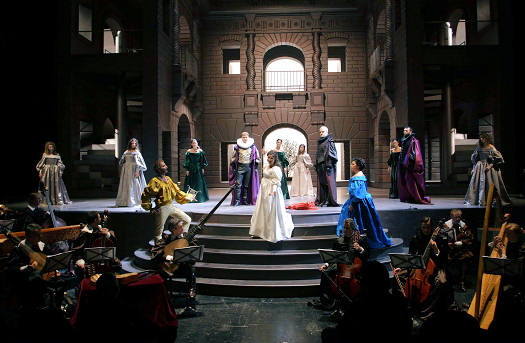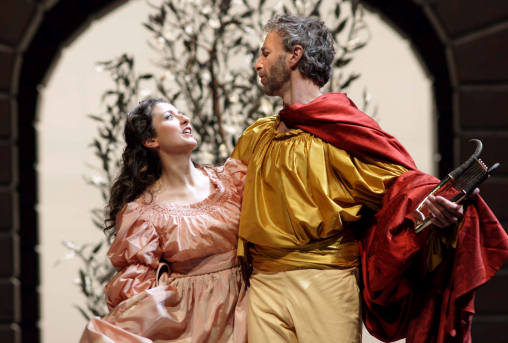Other Links
Editorial Board
- Editor - Bill Kenny
- London Editor-Melanie Eskenazi
- Founder - Len Mullenger
Google Site Search
SEEN AND HEARD INTERNATIONAL OPERA REVIEW
Monteverdi, Orfeo:
Soloists, Les Arts Florissants and Les
Sacqueboutiers de Toulouse, Conductor: William Christie,
Teatro Real de Madrid.
13. 5.2008. (JMI)
New production from Teatro Real
co-produced with Venice’s la Fenice.
Director: Pier Luigi Pizzi
Sets and Costumes: Pier Luigi
Pizzi
Lighting: Sergio Rossi
Cast:
Orfeo: Dietrich Henschel
Euridice, Proserpina and La Musica: Maria Grazia Schiavo
La Messagiera, La
Speranza: Sonia Prina
Plutone: Antonio Abete
Caronte: Luigi De
Donato
Apollo: Agustín Prunell-Friend
Ninfa: Hanna Bayodi-Hirt
Shepherd: Xavier Sabata

This Monteverdi Orfeo
arrives at the Teatro Real about a year late, since in February
of last year we were celebrating the 400th anniversary
of its premiere at Mantua's Ducal Palace. But whether it was
on time or not is immaterial;
what counts is the quality of the performance, which has not always
been the primary concern of the many Monteverdi Orfeos given during
the past
year. This time, the Teatro Real made a great effort,with a new
production and a musical ensemble of the first order. A high
quality 401st aniversary beats a mediocre 400th every time.
Pier Luigi Pizzi
was in charge of this new production in collaboration with Venice
Teatro de la Fenice. If there is a stage director known for his
aesthetic creativity, this is Pizzi, who has found renaissance and baroque opera,
to be the
perfect field for his art
for some twenty years or more. The
number of his baroque
productions is almost endless and they have always been
beautiful from an aesthetic perspective, though often with weak stage direction,
which not at the same level than his
beautiful sets and costumes. In this Orfeo, Pizzi has been
true to
himself and has offered a very attractive,
even original,
staging
during the first half of the opera, while not maintaining same
level of interest during the second. Stage and pit are not
two different elements here as the musicians are part of the production,
beginning with the colourful costumes that Pizzi designed for them
as
an evocation of the Orfeo premiere. William Christie himself enters the pit with a costume
of the period with ruff and large red cape. While we listen to most famous Toccata, the stage is
raised to reveal a large yard in Gonzaga Palace full of his guests. We are in the Palace
rather than the usual theatre within
a theatre, which makes much more sense, since Orfeo was premiered
at
the Palace and not the Court theatre. The beauty of the Palace,
the rich colour of costumes and the movement of the extras and dancers,
create an outstanding staging during the first half. The
production falls down in the later, with a rather poor
presentation of Hades, which doesn't improve much with
Orfeo's return to Thrace. The final explosion of joy from the
whole company, led by Pizzi himself, looks as though it's
deliberatley designed to get the best applause possible from the audience, which
it does. All in all, the
production combines excellence with the mediocre, just like life itself.

L’Orfeo is not an opera dependent only on vocal
pyrotechnics, but needs a group of singers working together in
the service of
the score. In this sense, the cast was thoroughly suited, homogenous
and musical at every turn. The German baritone Dietrich
Henschel was a convincing Orfeo, taking part in some of
the dancing in the first half. He was a good actor and always
musical, choosing
the ornamented version
for his third act
arioso
“Possente spirto”. Italian soprano Maria Grazia
Schiavo confirmed the positive impression she left in Vivaldi's
Bajazet. She was outstanding in the Prologue as La Musica,
singing with
beautiful piani. She was also fine as Euridice but was
slightly taxed as Proserpina, where I prefer a mezzo-soprano.
Sonia Prina
doubled as La Messagiera and La Speranza, singing with great
musicianship and
expressiveness. Antonio Abete was a good Plutone too, while Agustín
Prunell-Friend gave his best to the coloratura of
Apollo. Luigi De Donato was more acceptable as Caronte than
in his last performance in Tamerlano, but in fact all the secondary roles were very
well served.
This was the first performance of
the run and the theater was sold out. The audince was
particularly receptive to Pizzi, Christie and Henschel.
Incidentally, I should mention that
Monteverdi's Orfeo arrived in Spain a mere 348 years after its premiere in
1607. Being fashionable is obviously very important
here.
José M. Irurzun
Pictures © Javier del Real
Back to Top Cumulative Index Page
